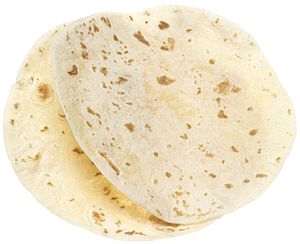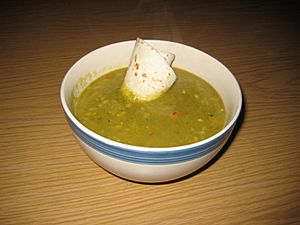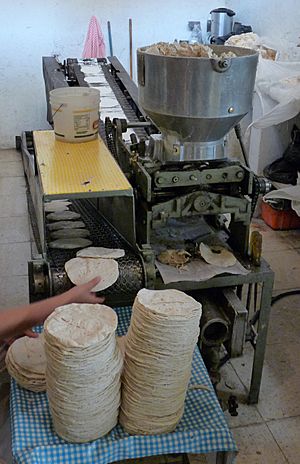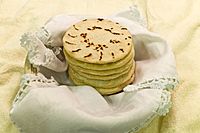Flour tortilla facts for kids

Flour tortilla
|
|
| Type | Flatbread |
|---|---|
| Place of origin | Mexico |
| Main ingredients | Wheat flour |
A flour tortilla is a soft, thin flatbread made from finely ground wheat flour. It was first inspired by the corn tortilla from Mexico. Corn tortillas are a flatbread made from maize (corn). They existed long before Europeans came to the Americas. Flour tortillas are made from a dough of flour and water. They are pressed flat and cooked, much like corn tortillas. Simple recipes use only flour, water, fat, and salt. But many store-bought tortillas also have ingredients like baking powder. These help them rise a little.
Contents
The Story of Flour Tortillas
The flour tortilla is a newer version of the corn tortilla. The word "tortilla" comes from Spanish. It means "small cake." The oldest tortillas ever found are about 12,000 years old. They were made from native maize. Corn tortillas were a main food for the Aztecs. They were also important for other ancient civilizations in Mesoamerica. Flour tortillas were invented much later.
Some people say flour tortillas started in northern Mexico. States like Chihuahua and Sonora grow more wheat than corn. So, it made sense to use wheat there. Today, flour tortillas are a big part of Mexican American food. They are also key in Mexican and Tex-Mex cooking. Many believe they became popular in Alta California. This was when California was still part of Mexico. The first large-scale flour tortilla factories were in Los Angeles.
What Does 'Tortilla' Mean?
The word tortilla comes from the Spanish word torta. Torta means "cake." The ending -illa means "little." So, tortilla literally means "little cake."
In Spain, tortilla also means omelette. So, this wheat flour flatbread is not the same as a Spanish omelette. A Spanish omelette is made with eggs.
How Flour Tortillas Are Made

Wheat tortillas are a common food in northern Mexican states. These include Sonora and Chihuahua. They are also popular throughout the Southwestern United States.
Tortillas come in many sizes. They can be small, about 6 centimeters (2.4 inches) wide. Or they can be very large, over 30 centimeters (12 inches) wide. The size depends on where they are made. It also depends on what dish they will be used for.
Factories often add different things to tortillas. This helps make them easier to produce. It also controls their texture and flavor. These additions help them stay fresh longer. Scientists are working on ways to make tortillas in large amounts. They want to use only whole-wheat flour, water, oil, and salt. They are trying to use a fermented sourdough starter instead of chemicals.
Tortillas Today
Today, machines make tortilla making much faster. In the past, people used wooden presses. Now, big machines can make up to 60,000 tortillas every hour. Tortillas are made from cornmeal and wheat flour. You can find many flavors and types. You can buy them in stores or make them at home.
Tortillas are still a main food in Mexico and Central America. They are also very popular in other places. In the U.S., tortillas used to be seen as an "ethnic" food. Now, they are a common food for everyone. They are even more popular than bagels and muffins. Tortillas are the second most popular packaged bread in the U.S. (after sliced bread). The Tortilla Industry Association (TIA) says the tortilla business in the U.S. is huge. It makes about $6 billion each year. This includes tortillas, tortilla chips, and taco shells.
What's in a Tortilla?
Soft wheat tortillas use wheat as their main ingredient. A popular brand, Mission Foods, lists many ingredients. These include enriched wheat flour, water, and vegetable shortening. They also contain salt, sugar, and leavening agents. Other ingredients help with freshness and texture.
A famous chef, Rick Bayless, has a simple recipe. His recipe uses only four ingredients. These are flour, lard, salt, and water.
A 49-gram wheat tortilla from the Mission brand has:
- Total Fat: 3.5g (5% of daily allowance)
- Sodium: 420 mg (18% of daily allowance)
- Total Carbohydrate: 24g (8% of daily allowance)
- Dietary Fiber: 1g (4% of daily allowance)
- Protein: 4g
- Calcium: 8% of daily allowance
- Iron: 8% of daily allowance
How People Use Tortillas
Flour tortillas have even been used on American spaceflights since 1985. They are a good solution for eating in microgravity. They help stop bread crumbs from floating around. This protects sensitive instruments.
In Mexico
In Mexico, the word "tortilla" usually means the common corn tortilla. But in northern Mexico, flour tortillas are very popular. They are used to make burritos. Flour tortillas are also popular in Tex-Mex food, like fajitas. In northern Mexico, people often eat flour tortillas with beans and eggs. Many dishes there use flour tortillas. These include quesadillas, burritos, chimichangas, and fajitas. The flour tortilla is like a sister to the corn tortilla, which came first. In central and southern Mexico, corn tortillas are more common. But in northern Mexico, flour tortillas might be just as popular, or even more so.
Flour tortillas are often filled with different foods. These can be meat, chopped potatoes, refried beans, cheese, or hot sauce. They are used to make dishes like tacos, quesadillas, and burritos. Burritos first came from the area near Ciudad Juarez, Chihuahua, Mexico, and El Paso, Texas.
In the United States and Northern Mexico
In Northern Mexico and much of the United States, "tortillas" usually mean wheat-flour tortillas. They are a basic food in Mexican border cooking. Their popularity grew because wheat flour was cheap. Also, they were easy to store and ship.
In Guam, flour tortillas are called titiyas. They are often eaten with kelaguen mannok.
Some artists even use tortillas for painting! This is called Tortilla art. The tortillas are baked and covered in acrylic paint. Then, they are painted.
In Central America
Tortillas in Central America can be a bit different from Mexican ones. But they are made in a similar way. In Guatemala and El Salvador, tortillas are thicker. They are about 5 millimeters thick and 10 centimeters wide. This is like Mexican gorditas. The corn is soaked in water and lime. Then it is rinsed and ground. In El Salvador, people sometimes use sorghum if there isn't enough corn. Also in El Salvador, there is a very large, thick tortilla called a "chenga." Food is placed on top of it, like an edible plate. This is used to serve food to workers on farms.
Honduras is famous for using wheat flour tortillas to make baleadas. A baleada is a wheat flour tortilla folded in half. It is filled with things like beans, cream, and scrambled eggs.
You can often find corn and wheat tortillas in supermarkets in El Salvador and Costa Rica. These are usually made by Mexican companies.
Stuffed tortillas called pupusas are also a famous dish. They are a traditional food in El Salvador.
In the United States
Tortillas are widely used in the United States. They are used in Mexican recipes and many other dishes. The Tortilla Industry Association (TIA) estimated that Americans ate about 85 billion tortillas in 2000. This number does not even include tortilla chips! Tortillas are more popular than other ethnic breads. This includes English muffins, pita bread, and bagels.
Tortilla chips are made from corn tortillas. The tortillas are cut into wedges and then fried. They first became popular in the 1940s in Los Angeles, California. They were then made in large amounts. Corn tortillas for chips are made from corn, lime, and water. Fried chips also have salt and vegetable oil.
Flour tortillas are commonly used for burritos. They are also used to make fajitas, wraps, and sandwiches. People use them in quesadillas, casseroles, and stews. There are many other ways to use them too.
Many people in Northern Mexico and the Southwestern United States eat tortillas every day. Many restaurants use wheat flour tortillas in different recipes. These can be Mexican or other types of dishes. Many grocery stores sell tortillas that are ready to eat.
See also
 In Spanish: Tortilla de harina de trigo para niños
In Spanish: Tortilla de harina de trigo para niños




